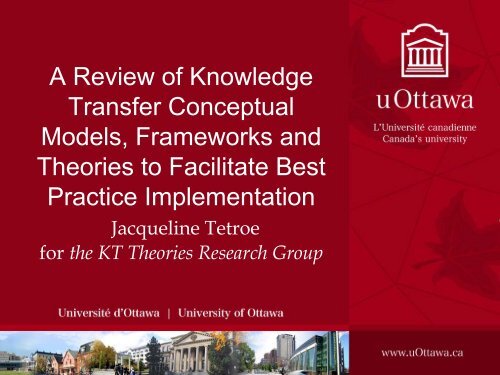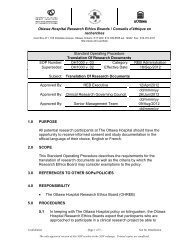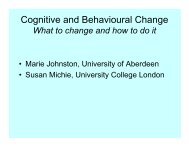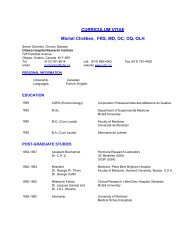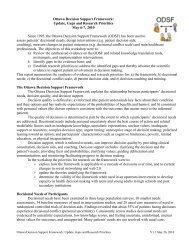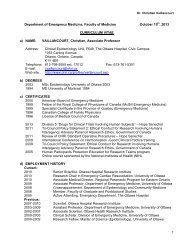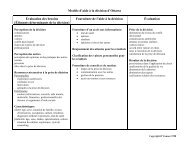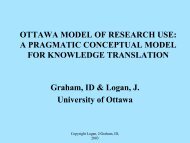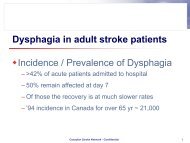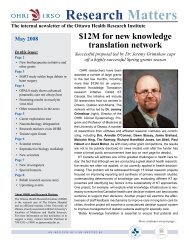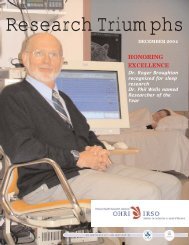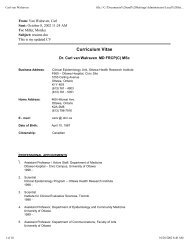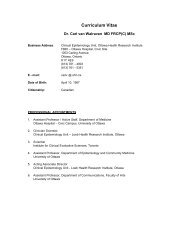A Review of Knowledge Transfer Conceptual Models, Frameworks ...
A Review of Knowledge Transfer Conceptual Models, Frameworks ...
A Review of Knowledge Transfer Conceptual Models, Frameworks ...
Create successful ePaper yourself
Turn your PDF publications into a flip-book with our unique Google optimized e-Paper software.
A <strong>Review</strong> <strong>of</strong> <strong>Knowledge</strong><br />
<strong>Transfer</strong> <strong>Conceptual</strong><br />
<strong>Models</strong>, <strong>Frameworks</strong> and<br />
Theories to Facilitate Best<br />
Practice Implementation<br />
Jacqueline Tetroe<br />
for the KT Theories Research Group
KT Theories Research Group<br />
• Doug Angus, U Ottawa<br />
• Melissa Brouwers, McMaster U<br />
• Barbara Davies, U Ottawa<br />
• Michelle Driedger, U Ottawa<br />
• Martin Eccles, Newcastle upon Tyne<br />
• Gaston Godin, U Laval<br />
• Ian Graham, U Ottawa (PI)<br />
• Jeremy Grimshaw, U Ottawa<br />
• Margaret Harrison, Queen’s U<br />
• Sylvie, Lauzon, U Ottawa<br />
• France Legare, U Laval<br />
• Louise Lemyre, U Ottawa<br />
• Jo Logan, U Ottawa (PI)<br />
• Jessie McGowan, U Ottawa<br />
• Marie Pascal Pomey, U Ottawa<br />
• Dawn Stacey, U Ottawa<br />
• Jacqueline Tetroe, U Ottawa<br />
• Michel Wensing, U Nijmegen<br />
-3 countries,<br />
-6 universities,<br />
-9 disciplines (education, geography, library science, management,<br />
medicine, nursing, population health, psychology, sociology)
Acknowledgements<br />
• Canadian Institutes <strong>of</strong> Health Research<br />
• Our research staff: Nicole Robinson, Christine Davies, Tyler<br />
Johnson, Louise Zitzelsberger
Background<br />
• <strong>Knowledge</strong> translation is a relatively new field <strong>of</strong><br />
inquiry in health care<br />
• Many existing knowledge translation theories are<br />
either not known or poorly understood due to<br />
disciplinary divides<br />
• Tendency for most best practice implementation<br />
projects to take a largely atheoretical approach<br />
• As is the case with all developing sciences, the<br />
success <strong>of</strong> the field is related to its theoretical<br />
foundation<br />
• Work is needed to identify knowledge transfer<br />
theories that have been developed in various<br />
disciplines and to critically review them to<br />
determine their similarities, differences, strengths<br />
and limitations
Objectives<br />
1)To conduct a focused search for conceptual<br />
models, frameworks, or grand theories <strong>of</strong><br />
knowledge translation (planned change)<br />
2) To undertake a theory analysis <strong>of</strong> the<br />
identified models to determine their strengths<br />
and limitations and to determine similarities<br />
and differences among them<br />
3) To determine the extent to which each model<br />
has been used and/or tested.<br />
4) Produce a users-guide to the theories<br />
(theories catalogue, synthesis <strong>of</strong> theory<br />
analysis)
Classical theories/models <strong>of</strong><br />
change<br />
• sometimes referred to as descriptive or<br />
normative theories<br />
• are passive<br />
• explain or describe how change occurs<br />
• Examples:<br />
– Roger’s diffusion theory<br />
– Kuhn’s conceptualization <strong>of</strong> scientific<br />
revolutions<br />
– Lomas’s Coordinated Implementation Model
Planned change theories/models<br />
What are they?<br />
• refer to deliberately engineering change that occurs<br />
in groups that vary in size and setting.<br />
• those who use planned change theories/models may<br />
work with individuals, but their objective is to alter<br />
ways <strong>of</strong> doing things in social systems.<br />
• help planners or change agents control variables that<br />
increase or decrease the likelihood <strong>of</strong> the occurrence<br />
<strong>of</strong> change.
Characteristics <strong>of</strong> Planned Action<br />
Theories<br />
• Explicitly state that goal <strong>of</strong> theory is to<br />
promote, plan or implement change<br />
• Suggest steps/stages to assist in<br />
achieving the goal<br />
• Focus on practitioner or organizational<br />
change and not on the public or<br />
consumers
Methods<br />
• Focused literature search <strong>of</strong>:<br />
– health sciences, (underway- social<br />
sciences, management, education)<br />
literature (over 4,000 hits)<br />
– internet<br />
• Still to be done<br />
– hand searching <strong>of</strong> the journals Science<br />
Communication; <strong>Knowledge</strong>, Technology<br />
and Policy
Methods<br />
• Theory analysis:<br />
– A theory analysis is a systematic examination <strong>of</strong> a theory or theories and is<br />
an essential component <strong>of</strong> theory development (Walker and Avant, 2004).<br />
– The purpose <strong>of</strong> a theory analysis is to determine the strengths and<br />
limitations <strong>of</strong> a theory.<br />
– During the theory analysis, we aim to:<br />
• determine the origins;<br />
• examine the meaning;<br />
• analyze the logical consistency;<br />
• define the degree <strong>of</strong> generalizability and parsimony; and<br />
• determine the testability <strong>of</strong> each theory<br />
– The analysis is being conducted using a standardized data abstraction form<br />
– At least 1 co-investigator and 1 research assistant abstracts data on each<br />
theory<br />
– Disagreements are resolved by consensus
Results<br />
• Data presented today based on 30 models/frameworks:<br />
– 14 frameworks<br />
– 16 models<br />
• Year published:<br />
– 1994-2005 (Median 2000)<br />
• Country <strong>of</strong> origin:<br />
– USA (n=10)<br />
– Canada (n=7)<br />
–UK (n=4)<br />
– Netherlands (n=2)<br />
– Not stated (n=7)
Results<br />
• Intended focus:<br />
– Health care (n=25)<br />
– Management (n=3)<br />
– Psychology (n=1)<br />
– Social work (n=1)<br />
• Intended Purpose:<br />
– Guide practice (n=22)<br />
– Guide research (n=5)<br />
– Guide theory (n=1)<br />
• Disciplines:<br />
– Nursing (n=9)<br />
– Interdisciplinary (n=8)<br />
• Intended audiences:<br />
– Administrators/managers<br />
(n=21)<br />
– Practitioners (n=20)<br />
– Researchers (n=15)<br />
– Policy makers (n=10)<br />
– Patients (n=4)<br />
– Public (n=3)
Results<br />
• Source <strong>of</strong> the theory:<br />
– Literature (n=18)<br />
– Research (n=5)<br />
– Experience (n=3)<br />
– Not stated (n=4)
Results<br />
• Terms used to mean ‘knowledge to practice’:<br />
– <strong>Knowledge</strong> transfer/ research transfer/technology<br />
transfer/information transfer/ innovation transfer/<br />
best-practice transfer (n=15)<br />
– Evidence/research based (n=9)<br />
– Dissemination (n=5)<br />
– Diffusion/knowledge diffusion (n=5)<br />
– Implementation (n=5)<br />
– <strong>Knowledge</strong> utilization/uptake <strong>of</strong> research findings<br />
(n=4)<br />
– <strong>Knowledge</strong> translation/translating evidence into<br />
practice/translating scientific knowledge (n=3)
Results<br />
What components are in the models?<br />
• Major conceptual<br />
categories or factors:<br />
– <strong>Knowledge</strong>/Innovation<br />
• Evidence to be transferred<br />
• Evidence behind knowledge<br />
• Development <strong>of</strong> knowledge<br />
• Actionable messages<br />
• Attributes <strong>of</strong> the change<br />
– Audience concerns<br />
– Context and culture<br />
• Resources and support<br />
– Implementation related factors<br />
• Major action categories:<br />
– Identify the problem<br />
– Identify a need for change<br />
– Assess barriers<br />
– <strong>Review</strong> evidence/literature<br />
– Tailor intervention<br />
– Implement the change<br />
– Evaluate<br />
• Outcome evaluation<br />
• Pilot testing<br />
• Process evaluation<br />
– Disseminate<br />
– Maintenance <strong>of</strong> change<br />
– Linkage
Results<br />
• Logical consistency:<br />
– Not as easy as we<br />
thought it would be to<br />
assess (i.e. fairly<br />
subjective)<br />
– Still working out how<br />
to determine logical<br />
consistency<br />
– On first pass, none<br />
seem to lack logical<br />
consistency<br />
• Empirical testing:<br />
–Yes (n=9)<br />
–No (n=21)<br />
• Generalizability:<br />
– Yes supported with data<br />
(n=1)<br />
– Claimed but no data<br />
(n=4)<br />
– Seems to be (n=23)<br />
– Not sure (n=2)
Conclusions<br />
• There are lots <strong>of</strong> planned action theories out there<br />
• Nursing responsible for 1/3 <strong>of</strong> models/frameworks<br />
• Many models/frameworks have concepts in common<br />
• Most models/frameworks have not been tested<br />
• Generalizability <strong>of</strong> the models/frameworks is largely not<br />
known<br />
Practice/Policy Implications<br />
The information provided will have the potential to:<br />
• increase understanding <strong>of</strong> research utilization and may be<br />
useful to guide best practice implementation endeavors<br />
• may also provide foundational information upon which new<br />
theories or frameworks <strong>of</strong> knowledge translation may be<br />
derived.
Next Steps<br />
• Complete the search for theories/models<br />
• Survey theory/model originators<br />
• Conduct bibliometric analysis for data on testing & use <strong>of</strong> the<br />
theories/models<br />
• Refine the analysis<br />
• Create KT theories user-guide


